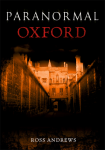
Reviewed by Tom Ruffles
Amberley Publishing continues its series documenting the country’s paranormal heritage. Ross Andrews contributes guides to Oxford and the Forest of Dean to add to his one on Cheltenham (reviewed for the SPR website by C J Romer). Andrews has a great deal of experience as a ghost hunter, including involvement with the Gloucestershire group PARASOC, and his enthusiasm is palpable. The emphasis in both these books is on presenting locations that can be visited, rather than accounts from anonymous premises, and they are organised into geographical sections making them ideal for the visitor with limited time.
The Oxford volume begins with a stroll round some of the city centre’s most haunted spots, including the site of the execution of the Protestant martyrs Latimer and Ridley, whose screams echo down history, the Sheldonian Theatre and Bodleian Library, and the Bridge of Sighs. The second chapter moves inside, taking in the theatres, a pub and an hotel. The third chapter is devoted to haunted colleges, and Oxford Castle has its own. A pair of chapters deals with miscellaneous Oxford ghosts and some further afield in the county.
Andrews notes that a lot of Oxford ghost stories hinge on town vs. gown, religion or the Civil War, so reading up on its ghosts is an opportunity to learn about the history of this beautiful city and the surrounding countryside. One gets the impression though that he has not personally carried out investigations here as the volume is free of case reports, with the stories being collected second-hand rather than resulting from local group activities.
The Forest of Dean volume is different in that respect. It covers mostly that part known as The Royal Forest Route, and unlike the Oxford book Andrews has first-hand experience of investigations in the area. Two chapters describe a variety of haunted locations in the forest, then one focuses on Littledean. Goodrich and Raglan Castles and Tintern Abbey have a chapter to themselves.
The meatiest section, almost half the book, is devoted to St Briavel’s Castle, which Andrews has examined extensively as a member of Phamtomfest, a non-profit group set up specifically to organise investigation there. He goes into considerable detail, outlining a wide range of phenomena. This is fascinating stuff, though it renders the book less useful for someone who wants a general guide to forest locations but does not have a particular interest in St Briavel’s Castle (and as he concedes, the level of detail provided may contaminate future reports). Both books conclude with brief sections of advice for the ghost hunter.
As with other Amberley guides the physical quality of the books is good, but the copy editing on these ones could have been tighter. Andrews writes clearly but the facetious tone does grate after a while. Both are well illustrated, mostly with the author‘s own photographs. If you want to have a handy and relaxed guide to the spookier elements of these places, Ross Andrews’ books are useful companions.

